Editor’s Note: Received from the Manufactured Housing Institute (MHI), July 2011, thanks to a communication from Executive Director Thayer Long
The Wall Street Reform and Consumer Protection Act of 2010 (or “Dodd-Frank”) is approximately 2,200 pages long and affects all financial service products, including manufactured home loans. Because of the legislation’s enormous size, complexity and its broad scope of impact, discussing it in piecemeal terms is difficult. Even within the banking industry, community banks have a different focus compared with the large national banks. For non-depository institutions, the same problem also exists.
Yet, there is a commonality of interest across a number of sectors. Dodd-Frank contains a number of unintended consequences that impact a variety of industries and consumers. For instance, with respect to the manufactured housing industry, Dodd-Frank was structured and written around a regulatory framework for real estate mortgages. However, the bill essentially reclassifies all manufactured home loans as mortgage products. Manufactured home loans not secured by real estate are not the same as mortgages. To regulate all home loans the same way is an unsuitable model, which creates significant challenges to the industry and the consumers it serves.
Manufactured home loans have unique characteristics. Manufactured home loans, in most cases, are much smaller than typical residential real estate secured mortgages and have shorter durations, which make transactional costs harder to recover. Manufactured home loans have higher servicing costs than residential mortgages, requiring specialized knowledge and more personal contact and less reliance on technology. Many manufactured home loans (with the exception of FHA Title I loans) are made with no government guarantees or potential losses to taxpayers.
How is the Industry Impacted?
First, the law creates a new standard for a “high-cost mortgage” loan which is based on interest rate spreads that fluctuate over time. If the Annual Percentage Rate (APR) exceeds the average prime offer (the loan purchase rate established by Freddie Mac) by more than 6.5 percent, or in personal property transactions under $50,000 by 8.5 percent, then the loan is considered “high cost.”
For example, if the law became effective today a “high-cost mortgage” loan is any residential loan over $50,000 with an APR of 11 percent or more, or, a loan under $50,000 (if the dwelling is considered personal property) with an APR of 13 percent or more. The law does not prevent “high-cost mortgage” loans from being made, but it does make it more difficult to make these loans, and it imposes a significant level of potential legal liabilities making them virtually impossible to securitize.
This is a problem because since our cost of capital is higher, manufactured home loan interest rates are typically higher. Since Fannie Mae and Freddie Mac do not purchase loans or create a secondary market where manufactured housing lenders can access capital at a discounted rate, lenders need to rely on other sources to make loans. These sources charge a higher interest.
Also, there are other fixed costs associated with making any kind of loan, such as fees for preparing the legal documents necessary to originate a loan. These basic costs increase with each state and federal law and regulation that is enacted. In addition, there are costs associated with each prospective borrower, including borrowers that are rejected and those who for whatever reason end up not taking the loan. These costs also include a portion of the advertising and marketing that go into borrower acquisition, the costs of maintaining methods of communication, and the costs of determining loan eligibility.
This conflict is particularly compounded with existing manufactured homes sales, where loan balances tend to be smaller. The loan may be smaller, but fixed costs are the same regardless of the loan size. These fixed costs must be recouped in some way in order to make the loan. Therefore, the only way to recoup these costs is by charging a higher rate.
If a lender decides to make a “high-cost mortgage” loan under Dodd-Frank, they must be prepared for a variety of new regulations, including
- requirements for borrowers to undergo loan counseling by a HUD-Certified Counselor, the cost of which is expected to be $400-$600;
- prohibitions that prevent financing points, fees and closing costs;
- rules limiting late fees; and
- rules requiring multiple disclosures to sell or assign “high cost” loans.
Second, Dodd-Frank does provide a path for relief through the definition of a “Qualified Mortgage (QM),” which is intended to provide a legal safe harbor from some of the Act’s more burdensome provisions. However, the criteria that must be met to be considered a qualified mortgage include:
- no balloon loans;
- points and fees are restricted to 3 percent of the loan amount;
- ability to repay must also consider taxes, insurance, and assessments; and
- standardization of debt to income guidelines that have not yet been determined.
Again, because of the nuances in manufactured home lending, the definition of QM is unworkable for many loans made in our industry. First, while balloon payments are not commonly made by manufactured home industry lenders, they are common with captive finance companies and local banks. Second, the cap of points and fees at 3 percent coupled with our smaller loan balances will force lenders to charge a higher interest rate (thus tipping the scales and classifying them as “high-cost mortgages.”)
Communicating this in detail is complicated because the law’s impact will vary from lender to lender depending on their business model and the types of loans that they make.
What is true of all of the existing non-captive lenders involved in manufactured home lending is there is a limit, which varies from organization to organization, of how small a loan they believe they can make and still recover a reasonable amount of their costs. Lenders will have to make a decision on what their lowest loan amount will be due to new limits on their ability to recover those costs. To better understand this, a lender has only three ways to recover costs which are:
- to buy the loan at a discount, which is only possible if there is a motivated seller involved in the transaction who is able and willing to accept a discounted payout;
- to charge the borrower additional closing costs; and
- to raise the interest rate and recover the costs as the borrower pays back the loan.
Even the strategy of using points to keep the interest rate below the triggers of a “high-cost mortgage” is impeded leaving no way to recover costs.
To further clarify, if the cost of origination and legal compliance equals X, that number does not change based on the loan size or duration. The shorter the term and the lower the dollar amount, the harder it is to recover those fixed costs. Here is an example:
A lender is considering making a $10,000 loan with a term of four years. Using a risk-based pricing model, the correct interest rate is determined to be 11 percent. If the fixed costs of origination are figured to be $2,000, the lender must charge the borrower either in points or closing costs that $2,000 to keep the rate at 11 percent. If a law or regulation caps the lender’s closing costs or points, then the lender must look to raising the interest rate to recapture whatever costs could not be recaptured through points or closing costs. If the entire cost were recovered via interest, the interest rate would need to be increased to 17 percent to recover the costs.
Captive finance companies currently have zero, or very low, minimum loan cutoffs.
Typically, they utilize higher interest rates to recoup costs, but often the justification for lending in the first place is that their related entities are profiting from the transaction in other ways, not the home loan itself.
What is the Result if Dodd-Frank is Not Amended?
Financing will still be available for those buyers with good credit and who can make a sizable down payment. Industry lenders that have or require higher credit quality customers may not be as impacted by the “high-cost mortgage” loan provisions. Those needing to serve customers with more challenged credit quality, and therefore needing to risk price their loans accordingly, will be impacted.
Also, those who fund low balance loans will find it more difficult to do business and existing homeowners will find it very difficult to sell their homes to buyers that need financing.
The dollar amounts for not making a loan will vary by lender because of all the variables detailed above, but each lender will find and set a minimum loan requirement based on their internal numbers.
It has been estimated that 50 percent of all the loans made on manufactured homes in manufactured home communities are under $25,000. Another source has estimated that nearly 75 percent of all manufactured home personal property loans are under $75,000.00. If the fixed transactional costs mandated by current and proposed law are higher than the lender’s ability to recover costs, the loan will not be made by lenders independent of other profit center relationships.
Bottom line is that without changes, there will be a significant number of consumers who will not be served.
Potential Solutions
MHI has an effort underway to seek bi-partisan legislative relief in six specific areas that needs and deserves the support of everyone in the manufactured housing industry. The issues identified by the MHI Dodd-Frank Task Force are as follows:
- Elimination of the expanded scope of Homeowners Equity Protection Act (HOEPA);
- Clarification of the Qualified Mortgage Standards;
- Clarification and Consistent Standards of a Mortgage Originator;
- Exemption of Manufactured Homes from the new Appraisal Standards;
- Exclusion of Manufactured Home Loans from the Residential Mortgage Loan Definition; and
- Clarification and strengthening of exemptions for manufactured home retailers from CFPB Oversight.
A six-page white paper created by MHI can be obtained from MHI or any state association. Industry members should obtain copies and distribute them to their Representatives and Senators along with personal letters and emails urging them to support this effort. Those reading this article should distribute it as widely as possible throughout the industry along with their personal efforts to persuade other industry members, including employees and community residents, as well as suppliers, to also contact their Representatives and Senators.
##
MHI is the preeminent national trade association for the manufactured and modular housing industries, representing all segments of the industries before Congress and the Federal government. This article was prepared with input from the MHI Dodd-Frank Taskforce, in particular Ken Rishel, Sheila Dey, Dick Ernst and TF chair Tim Williams.

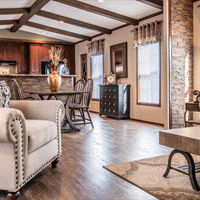

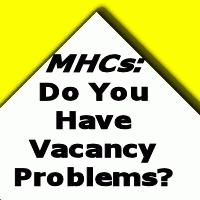
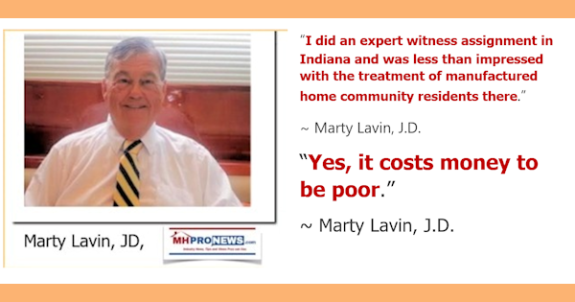
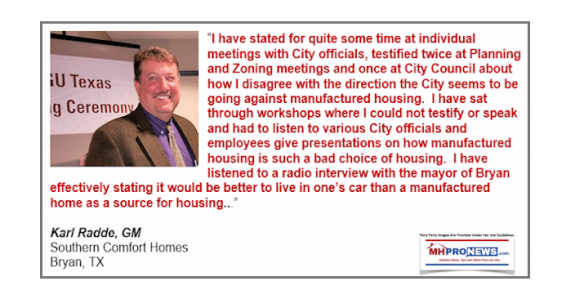
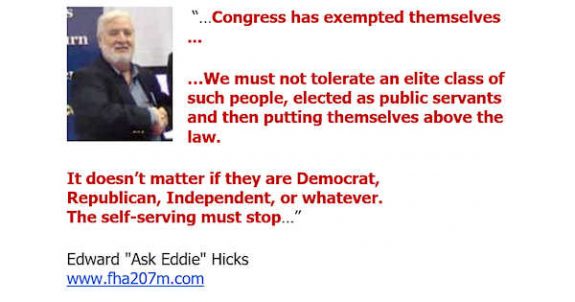
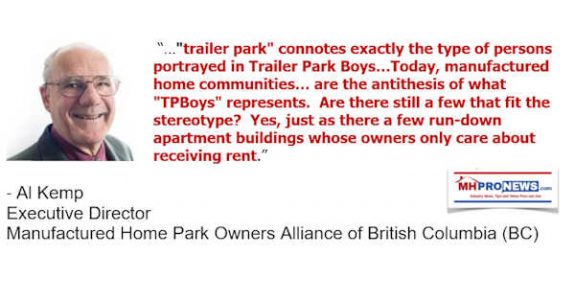
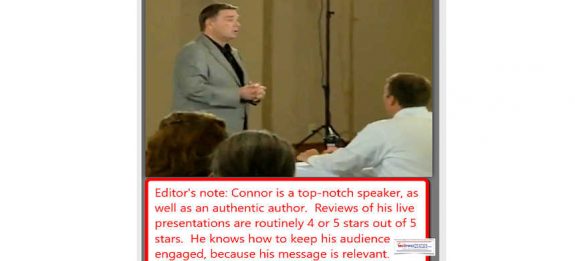
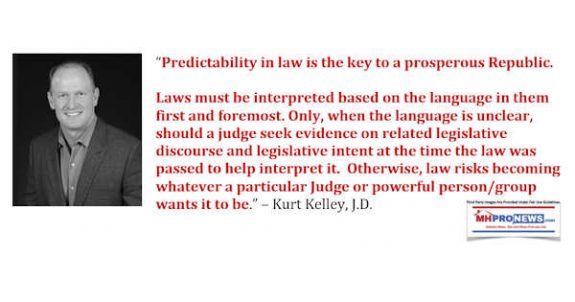
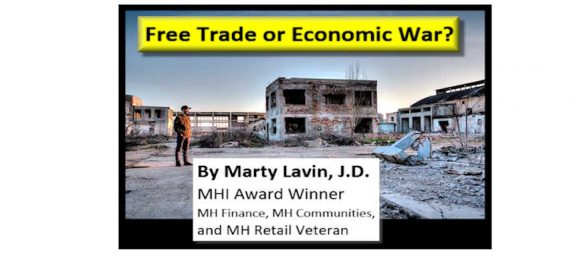
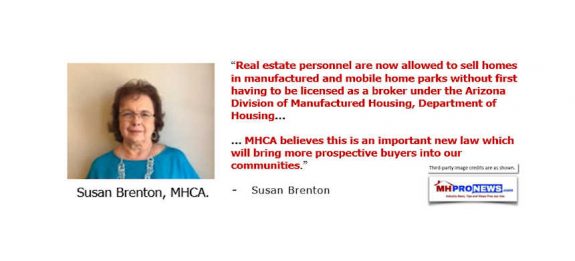
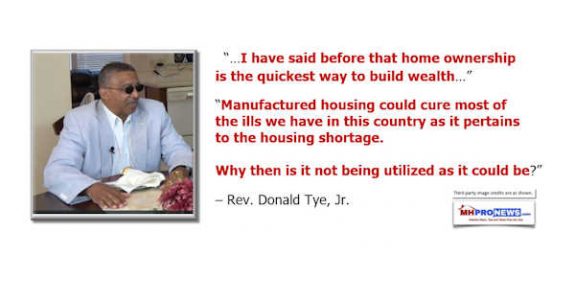
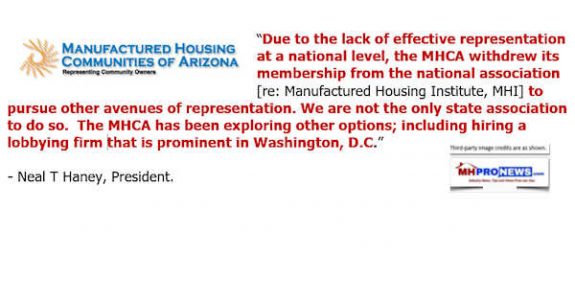
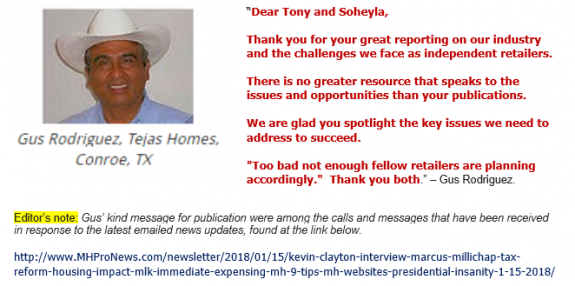
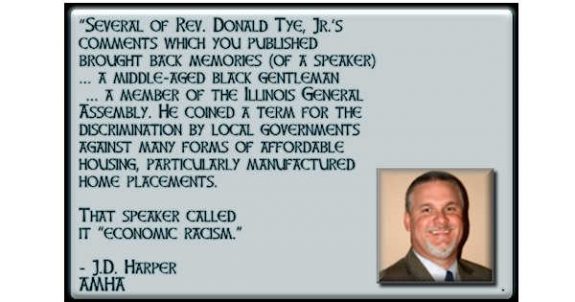
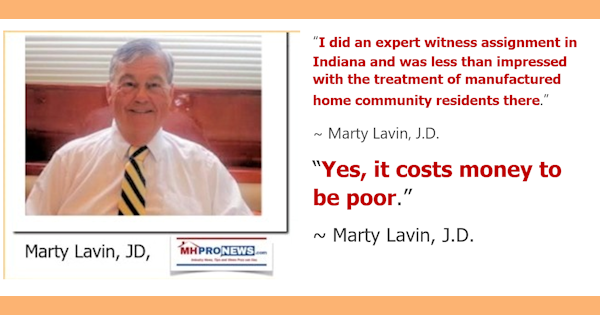
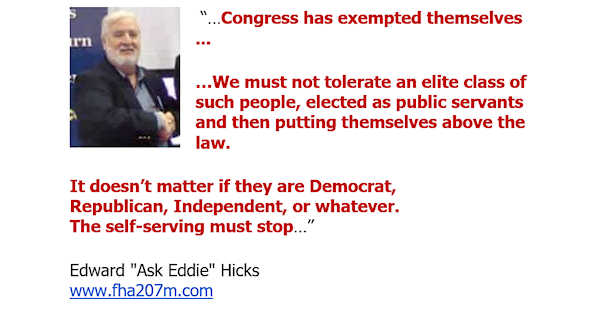
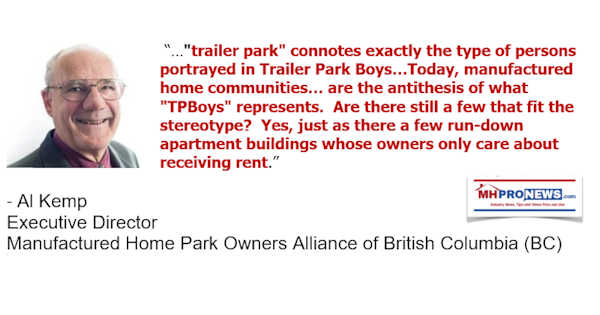
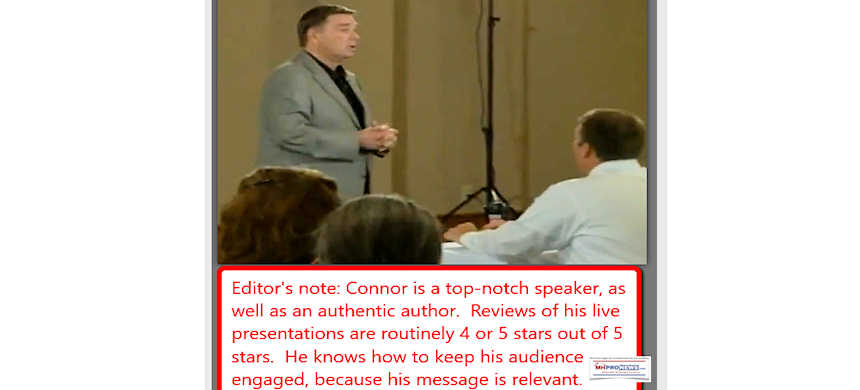
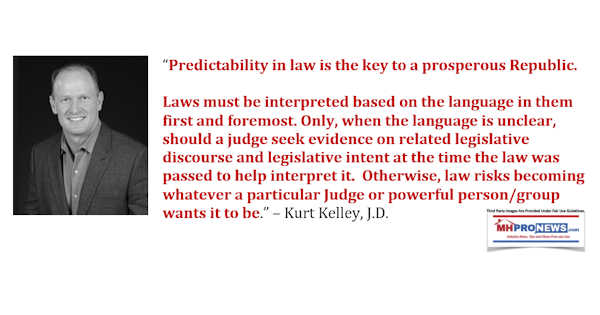
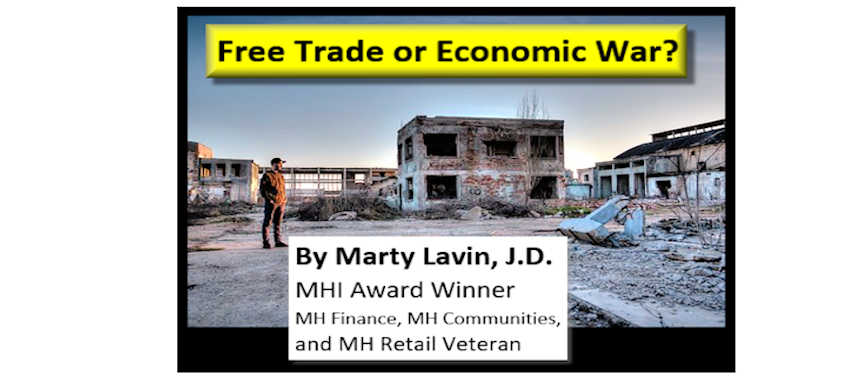
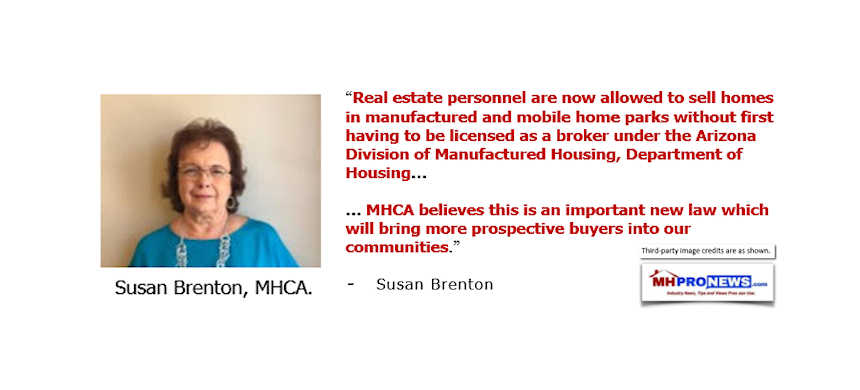
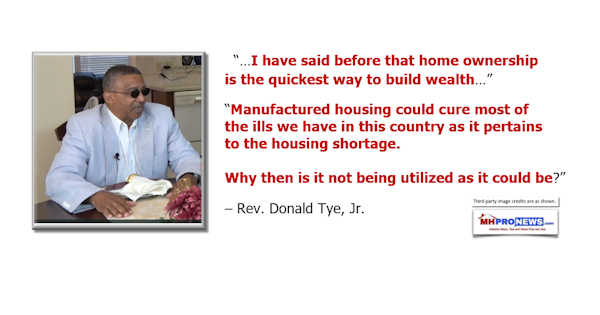
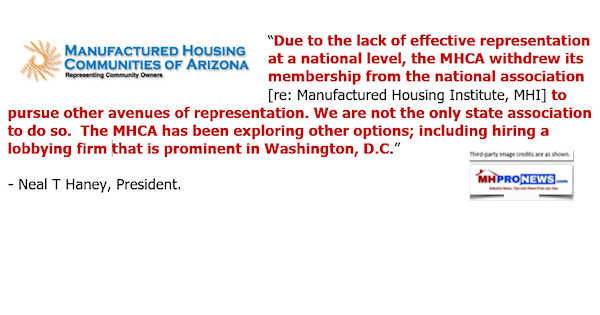
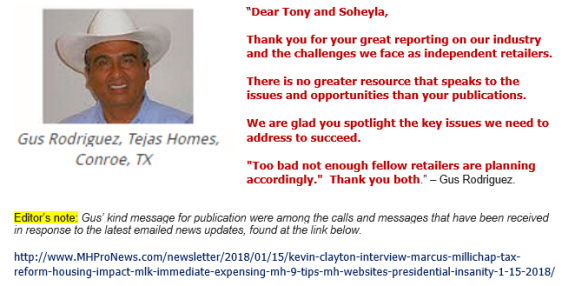
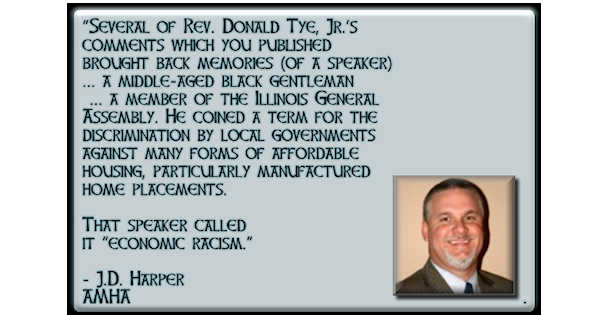
Karl Radde – TMHA, MHI, Southern Comfort Homes – Addressing Bryan City Leaders, Letter on Proposed Manufactured Home Ban
To All Concerned [Bryan City Officials, Others]: As the retail location referenced by Mr. Inderman, I would like to take a moment to address the …